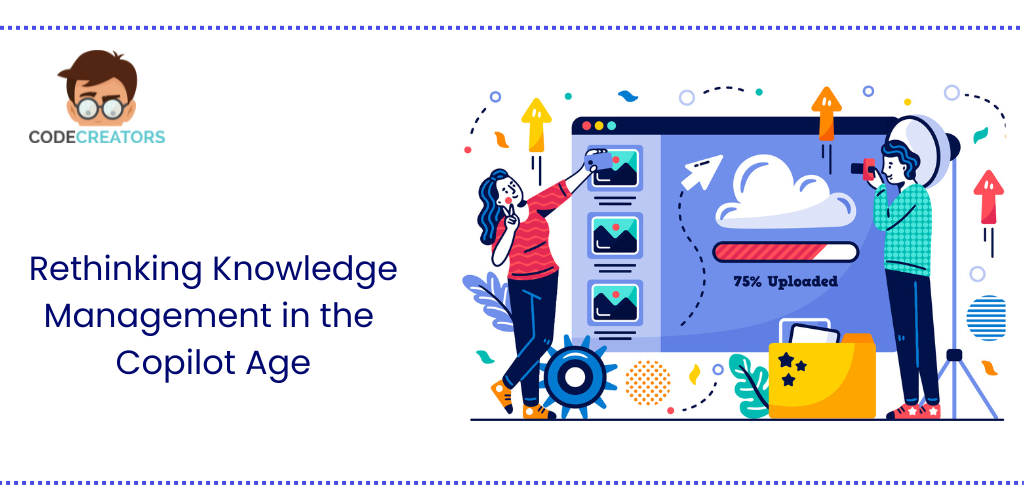Rethinking Knowledge Management in the Copilot Age

The rise of AI assistants, such as Microsoft Copilot, is driving a sea change in how organizations create, store, and access information-a fundamental shift that forces a complete revaluation of traditional knowledge management practices. For decades, the goal of KM was simply to capture knowledge; now, the challenge is to make knowledge instantly findable, contextualized, and accurate for AI consumption. This new reality is transforming knowledge management best practices and accelerating the adoption of advanced AI knowledge management tools. The future of business intelligence depends not on the amount of data you have, but on how well your AI knowledge management system prepares the data for the AI layer. This article explores this quiet revolution in detail, lays out the new requirements for KM, and shows why strategic deployment of AI for knowledge management has become critical.
The Pre-Copilot Knowledge Management Landscape
Traditional KM systems had two major hurdles: findability and adoption.
- The Repository Problem: Organizations created huge repositories, like SharePoint sites, Wikis, or stand-alone best knowledge management software, storing thousands of documents. The problem was that users often struggled to find the right document amidst the sprawl, even when advanced search was used.
- The Incentive Gap: Generally, it was either not rewarding enough or a time-consuming activity for employees to document knowledge. Expertise remained confined to emails, personal drives, or within the minds of employees themselves, thus creating personal knowledge management that was highly vulnerable to turnover.
This lack of timely access and incomplete data often undermines the advantages of knowledge management system software.
The AI Revolution: Convergence of AI and Knowledge Management
AI assistants don’t invent the answers; they synthesize information retrieved from your organization’s data ecosystem. This dynamic fundamentally changes the requirements for KM.
1. The Accuracy Imperative
As long as your source data in the KM system is only as good as Copilot accesses, if you have outdated policies, procedures that conflict, or facts that are not checked, it will surface these errors, leading to wrong advice.
- The Trust Layer: KM is now the trust layer for AI. You need to make sure that knowledge is formally verified and approved before it is ingested by the AI model.
2. The Contextualization Demand
AI needs context to give nuanced answers. Simple file names and folder paths are no longer good enough.
- Rich Metadata: You have to tag the documents with detailed, structured metadata. AI for knowledge management relies on this. For instance, a “Project Status” document should be tagged with Project Name, Status (Active/Archived), Authoring Department, and Confidentiality Level to allow the AI to filter and prioritize results accurately.
- Unified Semantics: You need to establish one single vocabulary, or taxonomy, throughout all departments. That means that if the Sales team calls a customer ID “Client ID,” but the Finance team calls it “Customer Ref,” the AI will struggle to connect related information.
New Knowledge Management Best Practices for the AI Age
By adopting these new best practices, KM can help secure the knowledge within your organization and ensure maximum benefits from AI.
1. Automated Curation and Review
Manual review cannot keep up with today’s volume. You have to automate the process.
- AI-Driven Tagging: AI knowledge management tools automatically analyze new documents and suggest relevant metadata tags, reducing the manual effort of classification.
- Scheduling Knowledge Audits: You can set policies that flag documents without an owner or that have not been reviewed in over six months. The system automatically assigns a review task to the correct knowledge domain expert.
- De-Duplication: AI in knowledge management identifies and flags ROT data (redundant, obsolete, and trivial), enabling the administrators to archive or delete data that is not needed, hence simplifying the search space for Copilot.
2. Shift from Capture to Retrieval Focus
The core requirement of the software behind the knowledge management system is no longer just storage but rapid and precise retrieval by AI.
- Structured Knowledge: You’ll need to take unwieldy, long-form documentation-think of a 50-page handbook for employees-and transform it into structured, easily digestible formats. Think short Q&A pairs or structured list items. AI can process these small, targeted chunks of knowledge much faster and more accurately.
- Graph Technology: Knowledge graph technologies are used to map out the relations between different pieces of information. For instance, the graph will show that “Policy A” replaces “Policy B” and is associated with “Training Course C.” This gives the AI critical context and keeps it from surfacing a document that has since been replaced.
3. Formalize the Personal Knowledge Management to Organizational KM Loop
The gap between individual expertise and documented organizational knowledge has to be filled.
- Incentivize Contribution: You integrate KM contribution into performance reviews, or you offer award recognition for high-quality knowledge submission.
- Capture in Workflow: You integrate knowledge capture right into the tools that employees are already using. Example: A customer service agent just solved a new technical issue. The system asks them to document the steps in the knowledge management system software before closing the ticket.
Key Features of Modern Knowledge Management System Software
For your best knowledge management software to succeed in the AI age, it needs to reflect these modern features, which offer the following important advantages of Knowledge Management System Implementation:
- Semantic Search: This ensures that the system understands the context and intent behind a search query; for example, searching “paid time off” will understand “vacation policy”. This greatly improves findability, making sure that the AI finds the best match.
- Knowledge Graphs: These map out the relationships between the various topics, people, and documents. Knowledge graphs allow the AI crucial context, therefore reducing the risk of hallucinations and outdated answers.
- Active Learning: how the system is used, meaning which knowledge is accessed and avoided. This will also help KM administrators to identify and prioritize knowledge that needs verification or updating.
- Automatic Summarization: AI for knowledge management summarizes long documents down to key facts. Copilot receives this pre-processed, concise knowledge block, enhancing the retrieval speed and precision.
Conclusion:
Artificial intelligence integrated with knowledge management forms the new frontier of enterprise efficiency. The era of just dumping documents into a repository is over. Safely and effectively leveraging tools such as Copilot requires a strategy of knowledge quality, contextual tagging, and automated curation. Knowledge management best practice now demands that organizations act as proactive editors of their data, with every piece of information checked for accuracy, relevance, and structure in its optimal form for AI consumption. This is the quiet revolution: by rethinking KM, organizations transform their core knowledge assets into a strategic, intelligent advantage.
FAQs
Q: Why is the quality of our knowledge base suddenly more important with the rise of AI tools like Copilot?
A: The quality of your knowledge base is suddenly more important because AI assistants synthesize answers directly from your stored data. If your knowledge base contains outdated, inaccurate, or conflicting information, Copilot will surface these errors, leading to “hallucinations” or incorrect business advice. AI knowledge management relies on the principle of “Garbage In, Garbage Out.”
Q: How does the concept of “contextualization” change knowledge management best practices?
A: Contextualization changes best practices by shifting the focus from simple file storage to rich metadata tagging. AI needs structured context (like document status, department, and confidentiality level) to provide accurate answers. KM systems must move beyond folders and enforce detailed metadata to ensure the AI can prioritize the most relevant and accurate information.
Q: What is the role of a Knowledge Graph in an AI and knowledge management strategy?
A: A Knowledge Graph maps the relationships between different pieces of information (documents, people, concepts, policies). This provides crucial context for the AI, allowing it to understand connections and hierarchies (e.g., that “Policy A” supersedes “Policy B”). This is a key feature of modern knowledge management system software and reduces the risk of the AI providing obsolete answers.
Q: How can we bridge the gap between personal knowledge management and organizational knowledge?
A: You can bridge this gap by making knowledge capture effortless and mandatory within workflows. You integrate capture directly into the tools employees already use (e.g., prompting a service agent to document a new solution before closing a ticket). You also incentivize contributions through recognition or inclusion in performance reviews.


